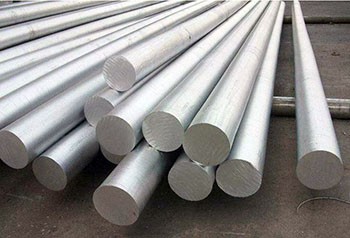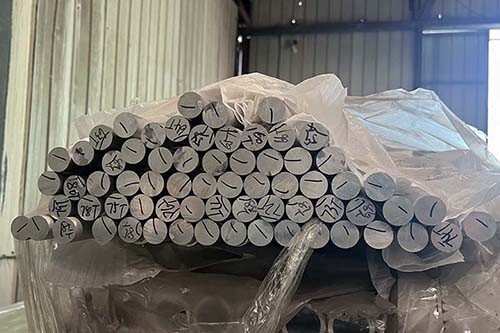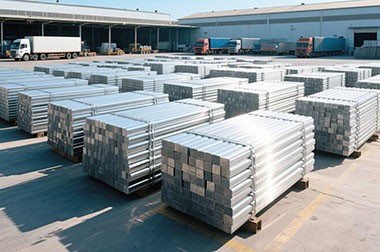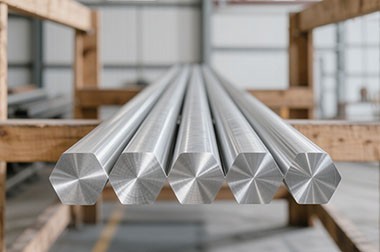5456 H321 Aluminum
5456-H321 aluminum belongs to the 5000 series wrought aluminum alloys, mainly alloyed with magnesium, and is not strengthened by heat treatment. Instead, its mechanical strength is enhanced through cold working (strain hardening) followed by a stabilization process. In the H321 temper, the alloy's hardness is approximately one-quarter of the difference between the fully annealed (O) and fully hardened (H38) tempers. This processing method achieves a balanced combination of high strength, moderate ductility, and excellent corrosion resistance, particularly against intergranular corrosion and exfoliation.
5456 H321 aluminum alloy is a high-performance aluminum-magnesium alloy material. H321 is the specific temper of this alloy, indicating that the material has undergone strain hardening followed by stabilization treatment. The H321 temper provides moderate hardness and a stress-relieved state. This process not only enhances the material’s strength but also imparts a certain degree of resistance to intergranular and exfoliation corrosion. With its excellent comprehensive properties, 5456 H321 aluminum alloy is widely used in shipbuilding, pressure vessels, aerospace, and other fields.
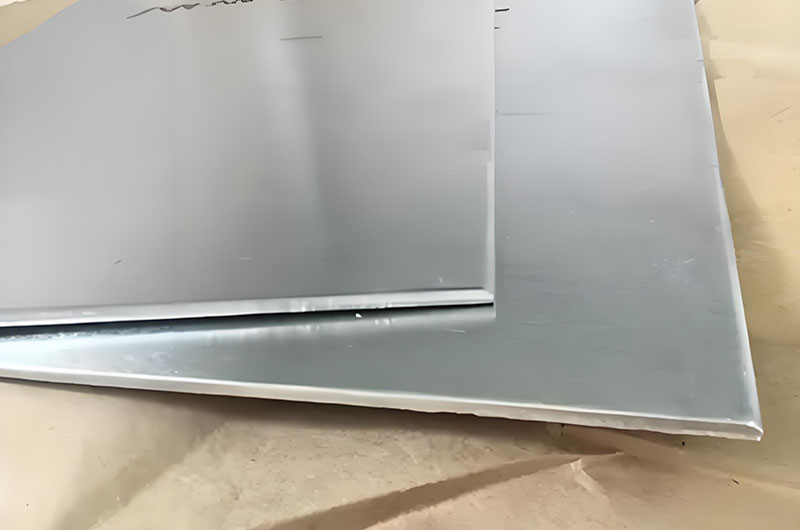
5456 H321 aluminum is a versatile and high-performance material, especially suitable for demanding marine environments and the shipbuilding industry. Its H321 temper offers a combination of strength, ductility, and corrosion resistance that is unmatched by many other aluminum alloys.
5456 H321 aluminum alloy has significant advantages in applications that require high strength, good corrosion resistance, and weldability. When selecting this material, one should weigh its performance characteristics and cost factors according to the specific application needs to achieve the best cost-performance ratio.
5456 H321 aluminum alloy is particularly suitable for applications requiring high strength and excellent corrosion resistance, especially in marine environments, and is therefore also known as "marine-grade aluminum alloy."
5456 H321 Temper Designation Explanation
The H321 temper designation indicates a specific processing history that imparts particular mechanical and corrosion-resistant properties to the aluminum alloy. Below is a detailed explanation:
H indicates that the material has undergone strain hardening (cold working)
The 3 following H indicates the material has been strain hardened and then stabilized
21 denotes the degree of strain hardening and stabilization:
- The metal has been strain hardened to achieve a strength approximately 25% between the annealed (O) and full-hard (H38) tempers
- This process also ensures the material retains a certain degree of resistance to intergranular and exfoliation corrosion
The "21" in H321 denotes a specific combination of cold working and stabilization, enabling controlled mechanical properties and corrosion resistance.
This temper is specially designed to achieve a good balance between strength and formability, while meeting the stringent corrosion resistance requirements of marine applications.
H321 Temper 5456 Aluminum Features
- Heat Treatment Process: The H321 temper is achieved by strain hardening followed by a stabilization treatment to stabilize the alloy at a specific temperature. The goal of this process is to enhance the alloy's strength while ensuring a certain level of corrosion resistance. Compared to T-series tempers (such as T6), the strength of H321 is slightly lower, but its corrosion resistance and formability are better.
- Strength and Hardness: In the H321 temper, 5456 aluminum alloy has moderate strength, with its strength value lying between the annealed state (O) and the full hard state (H38), roughly one-quarter of the way. Although its strength is not as high as T-series alloys, it is still sufficient to meet the demands of structural components in most marine environments.
- Corrosion Resistance: This alloy has excellent corrosion resistance, particularly to seawater and marine environments. Due to its chemical composition, 5456 aluminum alloy can effectively resist intergranular corrosion and exfoliation corrosion when exposed to seawater or humid environments for extended periods.
- Formability and Weldability: 5456 aluminum alloy in the H321 temper retains good formability and weldability while maintaining a relatively high strength. This makes it highly suitable for the fabrication of complex ship structures and marine platform components.
5456 H321 Aluminum Standards and Certifications
- ASTM B928: Marine-grade sheet/plate specifications.
- ASTM B209: General sheet/plate standards.
- Aerospace: Compliant with standards such as QQ-A-250/9 and AMS 4344.
5456 H321 marine aluminum plates are certified by ABS, BV, CCS, DNV, KR, LR, NK, RINA, and other classification societies.
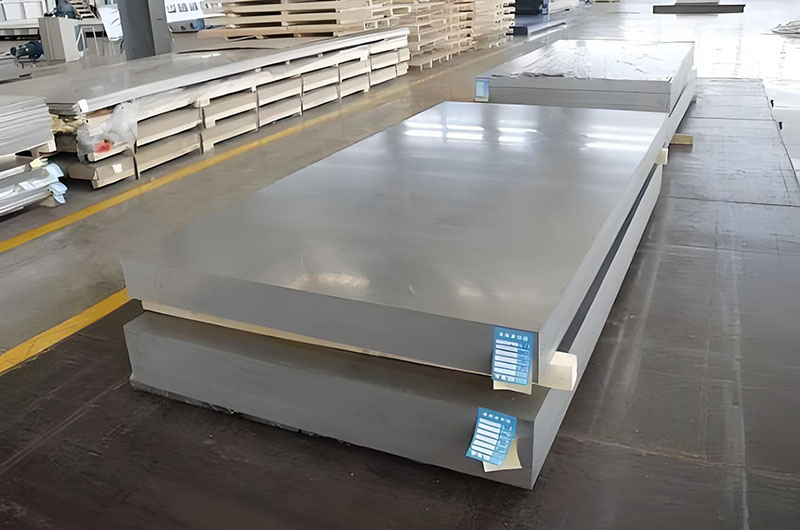
Common Specifications of 5456 H321 Aluminum
5456 H321 aluminum is available in various forms including sheets, plates, coils, and extrusions. The common thickness specifications for this alloy are:
Common specifications of 5456 H321 aluminum sheet and plate
- Sheet: typical thickness range is from 0.010 inch to 0.250 inch (0.25mm to 6.35mm)
- Medium-thick plates: thickness range generally from 0.250 inch to 1.500 inch (6.35mm to 38.1mm)
- Thick plates: thickness exceeds 1.500 inch (38.1mm), up to over 10 inches (254mm)
| Description | Thickness (in) | Width (in) | Length (in) |
| 5456 H321 aluminum sheet 0.125" | 0.125" | 48" | 96" |
| 5456 H321 aluminum sheet 0.125" | 0.125" | 48" | 120" |
| 5456 H321 aluminum sheet 0.125" | 0.125" | 48" | 144" |
| 5456 H321 aluminum sheet 0.125" | 0.125" | 60" | 120" |
| 5456 H321 aluminum sheet 0.125" | 0.125" | 72" | 144" |
| 5456 H321 aluminum sheet 0.25" | 0.25" | 48" | 96" |
| 5456 H321 aluminum sheet 0.25" | 0.25" | 48" | 120" |
| 5456 H321 aluminum sheet 0.25" | 0.25" | 48" | 144" |
| 5456 H321 aluminum sheet 0.25" | 0.25" | 60" | 120" |
| 5456 H321 aluminum sheet 0.25" | 0.25" | 72" | 144" |
| 5456 H321 aluminum plate 0.5" | 0.5" | 48" | 96" |
| 5456 H321 aluminum plate 0.5" | 0.5" | 48" | 120" |
| 5456 H321 aluminum plate 0.5" | 0.5" | 48" | 144" |
| 5456 H321 aluminum plate 0.5" | 0.5" | 60" | 120" |
| 5456 H321 aluminum plate 0.5" | 0.5" | 72" | 144" |
| 5456 H321 aluminum plate 1" | 1" | 48" | 96" |
| 5456 H321 aluminum plate 1" | 1" | 48" | 120" |
| 5456 H321 aluminum plate 1" | 1" | 48" | 144" |
| 5456 H321 aluminum plate 1" | 1" | 60" | 120" |
| 5456 H321 aluminum plate 1" | 1" | 72" | 144" |
| 5456 H321 aluminum plate 1.5" | 1.5" | 48" | 96" |
| 5456 H321 aluminum plate 1.5" | 1.5" | 48" | 120" |
| 5456 H321 aluminum plate 1.5" | 1.5" | 48" | 144" |
| 5456 H321 aluminum plate 1.5" | 1.5" | 60" | 120" |
| 5456 H321 aluminum plate 1.5" | 1.5" | 60" | 144" |
| 5456 H321 aluminum plate 1.5" | 1.5" | 72" | 144" |
Note
In the H321 temper, 5456 aluminum alloy plates are typically available in thicknesses ranging from 5mm to 38mm (approximately 0.20 inches to 1.50 inches). For thicker specifications (38mm to 76mm or 1.50 inches to 3.00 inches), the material is usually supplied in the H116 temper.
Common Specifications of 5456 H321 Aluminum Alloy Coils
- Ultra-thin coils: 0.008 inches to 0.020 inches (0.20mm to 0.50mm)
- Thin coils: 0.020 inches to 0.125 inches (0.50mm to 3.18mm)
- Medium-thick coils: 0.125 inches to 0.315 inches (3.18mm to 8.00mm)
Common coil specifications
Thickness: 0.010 inches (0.25mm), Width: 48 inches (1219mm), Coil Diameter: Inner 12 inches (300mm)/Outer 35 inches (890mm)
Thickness: 0.020 inches (0.51mm), Width: 60 inches (1524mm), Coil Diameter: Inner 12 inches (300mm)/Outer 40 inches (1016mm)
Thickness: 0.063 inches (1.60mm), Width: 72 inches (1829mm), Coil Diameter: Inner 12 inches (300mm)/Outer 50 inches (1270mm)
Thickness: 0.125 inches (3.18mm), Width: 48 inches (1219mm), Coil Diameter: Inner 12 inches (300mm)/Outer 55 inches (1397mm)
Thickness: 0.250 inches (6.35mm), Width: 60 inches (1524mm), Coil Diameter: Inner 12 inches (300mm)/Outer 59 inches (1499mm)
Note
The maximum thickness of coils typically does not exceed 0.315 inches (8.00mm); materials thicker than this are generally supplied in plate form.
Common Specifications of 5456 H321 Aluminum Alloy Tubes
Outer Diameter Specifications of 5456 H321 Aluminum Tubes
Small diameter tubes: 0.500 inches to 2.000 inches (12.70mm to 50.80mm)
Medium diameter tubes: 2.000 inches to 6.000 inches (50.80mm to 152.40mm)
Large diameter tubes: 6.000 inches to 12.000 inches (152.40mm to 304.80mm)
Wall Thickness Specifications of 5456 H321 Aluminum Tubes
The wall thickness of 5456 H321 aluminum alloy tubes is related to the outer diameter:
- Thin-walled tubes: wall thickness 0.032 inches to 0.125 inches (0.81mm to 3.18mm)
- Medium-thick tubes: wall thickness 0.125 inches to 0.250 inches (3.18mm to 6.35mm)
- Thick-walled tubes: wall thickness 0.250 inches to 0.500 inches (6.35mm to 12.70mm)
Inner Diameter Specifications of 5456 H321 Aluminum Tubes
The inner diameter of the tube can be calculated by subtracting twice the wall thickness from the outer diameter. The following are examples of common inner diameter specifications:
- For a tube with an outer diameter of 1.000 inches (25.40mm) and a wall thickness of 0.063 inches (1.60mm), the inner diameter is 0.874 inches (22.20mm)
- For a tube with an outer diameter of 2.000 inches (50.80mm) and a wall thickness of 0.125 inches (3.18mm), the inner diameter is 1.750 inches (44.45mm)
- For a tube with an outer diameter of 4.000 inches (101.60mm) and a wall thickness of 0.250 inches (6.35mm), the inner diameter is 3.500 inches (88.90mm)
- For a tube with an outer diameter of 6.000 inches (152.40mm) and a wall thickness of 0.375 inches (9.53mm), the inner diameter is 5.250 inches (133.35mm)
Common Tube Specification Combinations for 5456 H321 Aluminum
- Outer diameter: 0.500 inches (12.70mm), Wall thickness: 0.063 inches (1.60mm), Inner diameter: 0.374 inches (9.50mm)
- Outer diameter: 1.000 inches (25.40mm), Wall thickness: 0.083 inches (2.11mm), Inner diameter: 0.834 inches (21.18mm)
- Outer diameter: 2.000 inches (50.80mm), Wall thickness: 0.125 inches (3.18mm), Inner diameter: 1.750 inches (44.45mm)
- Outer diameter: 3.000 inches (76.20mm), Wall thickness: 0.188 inches (4.78mm), Inner diameter: 2.624 inches (66.65mm)
- Outer diameter: 4.000 inches (101.60mm), Wall thickness: 0.250 inches (6.35mm), Inner diameter: 3.500 inches (88.90mm)
- Outer diameter: 6.000 inches (152.40mm), Wall thickness: 0.375 inches (9.53mm), Inner diameter: 5.250 inches (133.35mm)
Advantages of 5456 H321
- Its unique tempering process results in a strength approximately one-quarter between annealed and fully hardened states
- Excellent corrosion resistance, particularly against intergranular and exfoliation corrosion (major concerns in marine environments)
- Maintains high strength characteristics even below zero degrees
- Good weldability with suitable filler materials such as ER5356 or ER5556
- Versatile applications ranging from primary marine structures to various industrial uses
- Compared with other 5456 tempers and similar marine alloys, 5456 H321 offers balanced performance, making it a preferred choice for many marine applications.
Corrosion Resistance of 5456 H321 Aluminum
5456 H321 aluminum exhibits excellent corrosion resistance, especially in marine environments, thanks to its high magnesium content (4.7–5.5%) and the addition of trace elements such as chromium and manganese. The following are key aspects of its corrosion resistance:
Resistance to Marine Environments
This alloy demonstrates excellent resistance to saltwater corrosion, making it suitable for various marine applications.
Resistance to Intergranular and Exfoliation Corrosion
The H321 temper specifically enhances resistance to these types of corrosion, which are particularly problematic in marine environments.
Comparative Corrosion Resistance
H321 offers similar good corrosion resistance to H116 but with more stable performance
Compared to H116 aluminum plates, it has higher hardness and better stability, while maintaining excellent anti-corrosion performance even after painting
When combined with surface treatments such as anodizing or coating, 5456 H321 aluminum is suitable for freshwater applications in cargo ships, rowing boats, electric boats, pedal boats, and cruise ships.
Although 5456 H321 has excellent general corrosion resistance, like all aluminum-magnesium alloys, it should not be used continuously at temperatures exceeding 150°F (65°C) due to potential stress corrosion issues.
5456 H321 Aluminum Performance Features
- Alloy: 5456 belongs to the aluminum-magnesium alloy series (5000 series).
- Temper: H321 indicates strain-hardened and stabilized condition, offering a balance of strength and ductility.
- Corrosion resistance: Excellent, especially suitable for marine environments due to its magnesium content.
- Weldability: Good; 5356 or 5556 filler rods are recommended to maintain weld seam corrosion resistance.
- Strength: Medium strength, but can be enhanced through cold working.
- Machinability: Machinable but requires careful handling; typically uses coolants and appropriate tools.
- Formability: Moderate; requires cautious handling and proper techniques.
- Applications: Widely used in marine applications, shipbuilding, and other outdoor structures.
5456 Marine Grade Aluminum Plate Sheet Chemical Composition
| Alloy | 5456 | |
| Si | ≦0.25 | |
| Fe | ≦0.4 | |
| Cu | ≦0.1 | |
| Mn | 0.50-1.0 | |
| Mg | 4.70-5.50 | |
| Cr | 0.05-0.20 | |
| Zn | ≦0.25 | |
| Ti | ≦0.2 | |
| Zr | - | |
| Standard | EN573 | ASTM B928 |
5456 H321 Aluminum Mechanical Properties
| Property | 5456-H321 Aluminum |
| Brinell Hardness | 90 |
| Elastic (Young's, Tensile) Modulus | 9.9 x 10^6 psi |
| Elongation at Break (%) | 14 |
| Fatigue Strength | 31 x 10^3 psi |
| Poisson's Ratio | 0.33 |
| Shear Modulus | 3.7 x 10^6 psi |
| Shear Strength | 30 x 10^3 psi |
| Tensile Strength: Ultimate (UTS) | 50 x 10^3 psi |
| Tensile Strength: Yield (Proof) | 37 x 10^3 psi |
5456 H321 Aluminum Thermal Properties
| Property | 5456-H321 Aluminum |
| Latent Heat of Fusion | 390 J/g |
| Maximum Temperature: Mechanical | 370°F |
| Melting Completion (Liquidus) | 1180°F |
| Melting Onset (Solidus) | 1060°F |
| Specific Heat Capacity | 0.22 BTU/lb-°F |
| Thermal Conductivity | 68 BTU/h-ft-°F |
| Thermal Expansion | 24 µm/m-K |
5456 H321 Aluminum Electrical Properties
| Property | 5456-H321 Aluminum |
| Electrical Conductivity: Equal Volume | 29% IACS |
| Electrical Conductivity: Equal Weight | 97% IACS |
Marine Applications and Shipbuilding Uses of 5456 H321 Aluminum
Due to its high strength, corrosion resistance, and weldability, 5456 H321 aluminum is widely used in marine applications and the shipbuilding industry. Below are its specific applications in this field:
5456 H321 Aluminum for Ship Structures
Primary Hull Structures: 5456 H116 and H117 (similar to H321) are considered the best materials for primary hull structures due to their advantages in mechanical properties, corrosion resistance, and cost
Deck Structures:
5456 aluminum plates are primarily used for ship decks
- Different temper levels can meet specific requirements of various ship decks, such as living decks, walking decks, and navigation decks
- Superstructures: Used to construct superstructures where lightweight and corrosion resistance are critical
Specific Ship Types
- High-speed vessels: Aluminum is the material of choice for designers of high-speed ships (e.g., fast boats, hydrofoils, offshore workboats, and yachts)
- Specialized vessels: Used in the construction of all-aluminum marine research ships, ocean-going commercial vessels, and passenger ships with capacities of thousands of tons
- Small vessels: Suitable for freshwater-operating boats such as properly treated cargo ships, rowing boats, electric boats, pedal boats, and cruise ships
Other Marine Applications
- Structural components: Widely used in ship plates, bottom plates, portholes, loading plates, and ship container side panels
- Docks and piers: Aluminum is used to build docks and piers, offering a durable and low-maintenance solution capable of withstanding prolonged water exposure
- Yachts and sailboats: High-end yacht and sailboat designs often use marine-grade aluminum for structural parts and aesthetic elements
5456 H321 aluminum is particularly suitable for these applications due to its ability to retain strength and corrosion resistance in harsh marine environments, while also providing the lightweight characteristics needed for efficient vessel operation.
Recommended Welding Filler Materials for 5456 H321 Aluminum
When welding 5456 H321 aluminum alloy, selecting the appropriate filler material is crucial to maintaining the alloy's desired performance. The following are key recommendations:
Primary Filler Alloys
- ER5356 is the most commonly used aluminum filler alloy
- ER5556 is also suitable for inert gas processes
Alloy Compatibility
- Specifically designed for 5xxx series structural alloys
- Offers better corrosion resistance in saltwater
Post-Weld Properties
- ER5356 provides a white color after anodizing
- Average tensile strength: ~38, 000 psi (262 MPa)
Temperature Limitations
- Not suitable for operating temperatures > 150°F (65°C)
- High temperatures may lead to stress corrosion
For best results, welding techniques and procedures suitable for aluminum-magnesium alloys should be used. Preheating is generally not required, but the base material and filler wire must be thoroughly cleaned to remove any oxide layers or contaminants that could affect weld quality.
Other Application Areas of 5456 H321 Aluminum
In addition to marine applications and shipbuilding, 5456 H321 aluminum is widely used across various industries and applications due to its excellent performance. Below are some other application areas of this alloy:
Industrial Applications
Pressure vessels and pipelines: The high strength of 5456 aluminum makes it highly suitable for high-pressure applications
Chemical storage tanks: Alloy 5454 (closely related to 5456) is widely used in the manufacture of chemical tanks
Storage tanks: Used to build tanks for various liquids and gases
Transportation Applications
Automotive components: Used in the production of car wheels and other parts requiring high strength and corrosion resistance
Cryogenic applications: Capable of withstanding extremely low temperatures without becoming brittle or losing performance
5456 H321 aluminum alloy is particularly suitable for applications that may experience temperatures exceeding 150°F (65°C), where other aluminum-magnesium alloys may face stress corrosion issues. 5456 H321 aluminum maintains strength and ductility across a wide temperature range, making it ideal for various industrial uses.
Comparison of 5456 H321 Aluminum with Other Alloys
Comparison of 5456 H321 with Other 5456 Tempers
5456 aluminum is available in multiple temper conditions, each offering different mechanical and performance characteristics. The following compares H321 with other common 5456 tempers:
5456 H321 vs. H116
Both offer good corrosion resistance
H321 provides more stable performance
H321 has higher hardness and better stability
Both are suitable for similar marine applications
5456 H321 vs. H32
Both are H3 tempers (strain-hardened and stabilized)
H321 has a higher degree of strain hardening
H321 offers a better balance of strength and ductility
5456 H321 vs. H112
H112 is formed by hot working
H321 is strain-hardened and then stabilized
H321 is typically used for plate applications
5456-H321 is a versatile aluminum alloy favored for its ability to withstand harsh environments while offering good strength and weldability.
Comparison of 5456 H321 with Other Marine Aluminum Alloys
When considering materials for marine applications, 5456 H321 aluminum is often compared with other high-performance marine alloys. Below is a comparison with some of the most commonly used alternatives:
5456 H321 vs. 5083
Both are 5xxx series aluminum-magnesium alloys
5083 has higher tensile strength
Both exhibit excellent corrosion resistance
5083 is better suited for cryogenic applications
5456 H321 vs. 6061
5456 is from the 5xxx series; 6061 is from the 6xxx series
6061 is heat treatable
6061 offers higher strength after heat treatment
5456 H321 offers better corrosion resistance
5456 H321 vs. 5086
5086 has higher strength than 5052 and 5083
5086 is strain-hardened rather than heat-treated
Both alloys offer high weldability
| Property | 5456 H321 | 5083 H116 | 5754 H111 | 5052 H32 |
| Corrosion Resistance | Good | Excellent | Good | Good |
| Weldability | Good, prone to cracking | Excellent | Good | Good |
| Machinability | Moderate | Good | Good | Excellent |
| Cost | High | Medium-High | Medium | Medium |
Comprehensive Advantages and Disadvantages of 5456 H321 Aluminum
| Advantages of 5456 H321 Aluminum | Disadvantages of 5456 H321 Aluminum |
| High strength | Relatively high cost |
| Good corrosion resistance | Difficult to machine |
| Excellent weldability | Susceptible to stress corrosion |
| Good low-temperature performance | Corrosion resistance inferior to 5083 |
| Good fatigue performance | Prone to weld cracking |
In marine applications, the selection of these alloys depends on the specific requirements of the project, including strength demands, corrosion resistance, temperature conditions, and manufacturing methods. 5456 H321 provides a good performance balance for general marine structural applications where both strength and corrosion resistance are critical.
Comparison with T6 Temper: Compared to the T6 temper (such as 5456 T6), the strength of H321 is lower, but it offers superior corrosion resistance and weldability. T6 temper alloys are more common in structural components that require high strength, but they do not provide the same level of corrosion resistance as H321.
5456 H321 aluminum alloy is widely used in marine environments, particularly in structural components for ships and offshore platforms. Through strain hardening and heat treatment, the alloy ensures excellent mechanical properties while providing outstanding resistance to seawater corrosion. While its strength is slightly lower than T-series aluminum alloys, its excellent corrosion resistance, good weldability, and formability make it a key material choice in the marine and shipbuilding industries.
5456 H321 Aluminum Processing Considerations
- Formability: Despite strain hardening, it retains good cold forming capabilities.
- Welding: Compatible with TIG and MIG methods, but post-weld heat treatment may be necessary for critical applications.
- Machining: Requires sharp tools to prevent galling due to its magnesium content.
5456-H321 aluminum is an excellent choice for applications that require a lightweight yet strong material with reliable corrosion resistance and good formability, making it suitable for structural components in pressure vessels, aerospace, and marine industries.
Recommended for you
-
5456 marine grade aluminum plate is an economical choice for ship construction. Can be used on baseboards, decks and other upper fittings.
-
5456-H111 aluminum alloy is commonly used in the marine and shipbuilding industries, particularly in environments that require resistance to seawater corrosion.
-
5456-H112 aluminum alloy is a cold-processed and heat-treated aluminum alloy, primarily used in fields that require high corrosion resistance and moderate strength, such as the marine and shipbuilding industries.
-
5456 aluminum alloy is a high-strength aluminum alloy widely used in marine, shipbuilding, offshore engineering, and other corrosion-resistant structural components.
-
5456 H32 aluminum alloy is widely used in the marine and shipbuilding industries. It has good corrosion resistance and is suitable for anti-corrosion structural components in seawater environments.
-
5456 O aluminum alloy is a state of the 5456 series, referring to the aluminum alloy that has been fully annealed (O state).
Other content readers are interested in
-
5456 5454 5754 Marine Grade Aluminum Bar
5456 5454 5754 Marine Grade Aluminum Bar has certification from CCS, DNV, NK, CCS, ABS, BV, LR, KR and other classification societies, and its quality fully complies with world marine grade standards.
-
Marine Grade Aluminum Round Bar 5754 5454 5456
The quality of 5754, 5456, and 5454 marine-grade aluminum round bars fully meets the ship classification standards worldwide: CCS, DNV, NK, ABS, BV, LR, KR.
-
5456 5454 5754 Marine Grade Aluminum Square Bars
As outstanding representatives of the Al-Mg series alloys, 5456, 5454, and 5754 marine-grade aluminum square bars each have unique performance advantages and application scenarios.
-
5454 5456 5754 Marine Grade Hexagonal Aluminum Bar
Haomei Aluminum is one of the leading 5454, 5456, 5754 aluminum hexagonal bar manufacturers in China, focusing on the research and development and production of high-quality products.
Recommended for you
-
5052 marine aluminum alloy is a high-strength, corrosion-resistant, easy-to-process and weld aluminum alloy, which is widely used in the manufacture of ships and marine structures.
-
5083 is basically used to manufacture ship hulls because of its relatively high strength and good corrosion resistance.
-
5059 aluminum is both a high-magnesium and high-zinc alloy, offering excellent corrosion resistance and fire resistance.
-
5086 aluminum alloy is irreplaceable in hull and deck applications in marine operating environments due to its unique seawater corrosion resistance, excellent low-temperature toughness, and good weldability.
-
5383 aluminum offers excellent fatigue resistance and crack resistance, and its unique properties make it irreplaceable in the design of high-speed vessels and marine structures that require long-term fatigue resistance.
-
5456 aluminum, with its unique high strength, exceptional fatigue resistance, and resistance to stress corrosion cracking, is irreplaceable in heavy-duty hull structures.
-
5754 aluminum is a medium-to-high strength alloy with excellent weldability, a low tendency for welding cracks, and high strength in both the weld joint and the crystalline metal.
More content of interest to readers
5456 Aluminum Properties 5383-O Aluminum vs. 5456-O Aluminum 5383-H32 Aluminum vs. 5456-H32 Aluminum 5383-H111 Aluminum vs. 5456-H111 Aluminum 5383 Aluminum vs. 5456 Aluminum 5383-H112 Aluminum vs. 5456-H112 Aluminum 5456-H116 Aluminum vs. 5456-H32 Aluminum 5086 Aluminum vs. 5456 Aluminum 5456-H112 Aluminum vs. 5456-H116 Aluminum 5456-H111 Aluminum vs. 5456-H116 Aluminum The application of 5456 aluminum plate in shipbuilding
You might be interested in: Marine Aluminum 5456 5 Series Marine Aluminum

